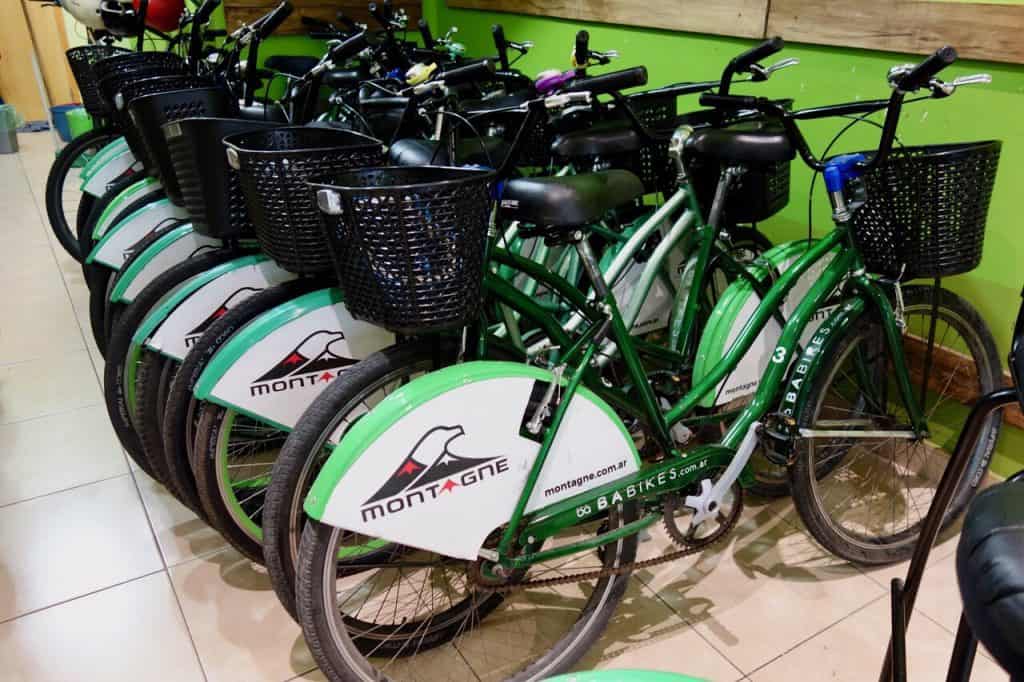
On our recent trip to South America, we started in Buenos Aires. The city has a European flair and is referred to as the “Paris of South America”. With its tree-lined streets, wide promenades and Parisian architecture, it’s easy to see why.
We wanted to get a flavour of what the town was about, not only from a cultural point of view, but from a food point of view. After all, one of the things we love at TFC is food. To cover both of these items, we decided to do a private biking and food tour with BA Bikes.
Now Mr. TFC, Pete, is an avid cyclist. He can often be found on a bike in Calgary, Italy or Toronto. Me, well, not so much, but what the heck, isn’t the expression “just like riding a bike”? Besides, Buenos Aires is mostly flat and cycling would be a good way to burn some of the calories that we had been and were going to be consuming.
We met up with Juan and Cesare at BA Bikes where we were outfitted with helmets, water bottles and bikes and discussed our route. Cesare was going to be our guide for the day and take us around to some of his favourite spots to see and places to eat. He started us off with some simple rules. Number one was “Do what I do” and number two was “Follow the traffic rules”. Good to know.
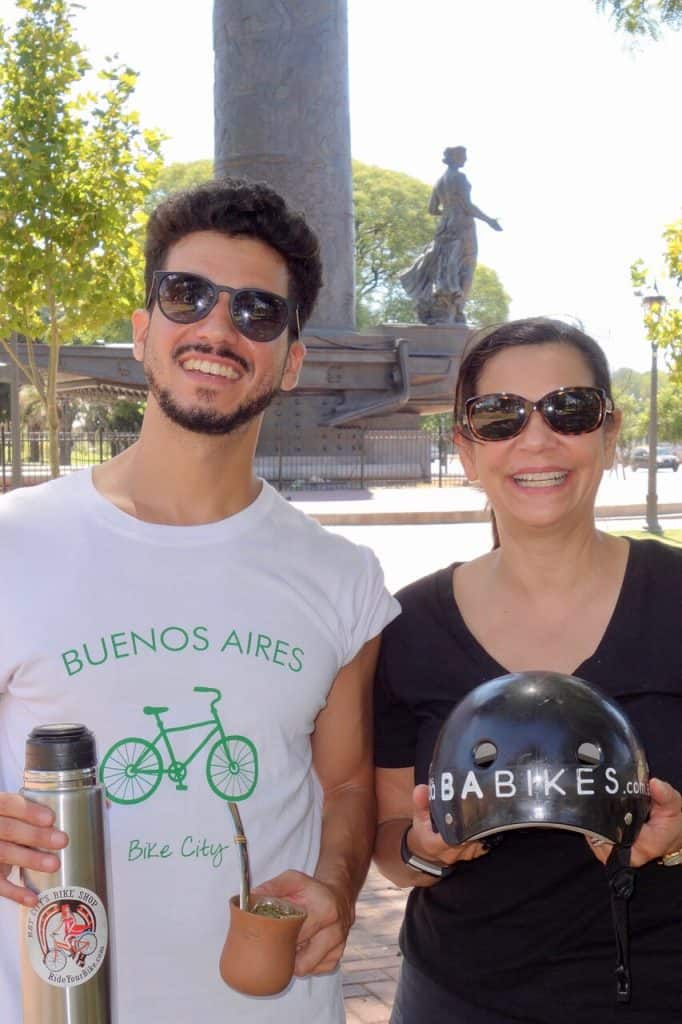
Since we had spent most of the previous day playing Cemetery Bingo, we made some changes to the pre-planned route and decided to stay in the southern part of the city, which we had not yet had time to explore. The southern part was where Buenos Aires began.
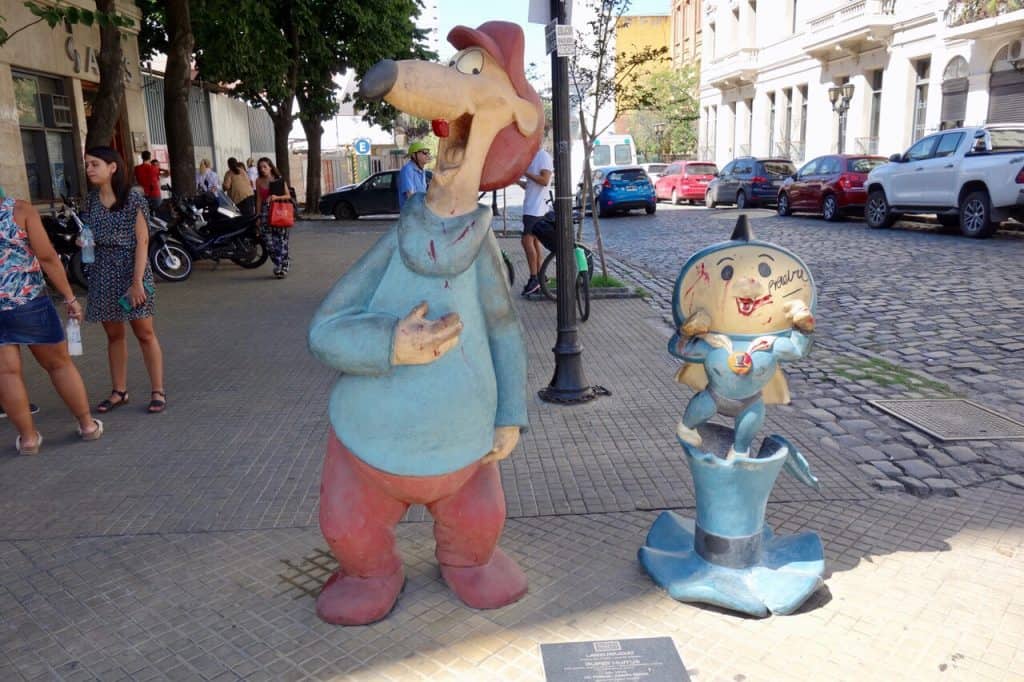
We started in San Telmo, which was the original Buenos Aires neighbourhood. Original colonial homes and cobblestone roads were very much in evidence. Cartoon characters were new additions to the neighbourhood – both the graffiti versions and statues put up by the city. San Telmo was the original area of the city where immigrants settled when they arrived from Europe. However, in 1870, yellow fever (I’m glad I got my shot before I left!) hit the city and the rich fled to country homes in Retiro, Palermo and Recoleta, leaving their fully-furnished houses behind. The poor people who were left behind moved into the empty homes and started selling the abandoned furniture. To this day, the area is full of antique stores and, every Sunday in the main square in San Telmo, there is a large antique market. To this day, San Telmo is a working class and immigrant neighbourhood. The cobblestones, while historical and attractive, make cycling quite challenging. After a few blocks of bumping along, we got to our next stop.
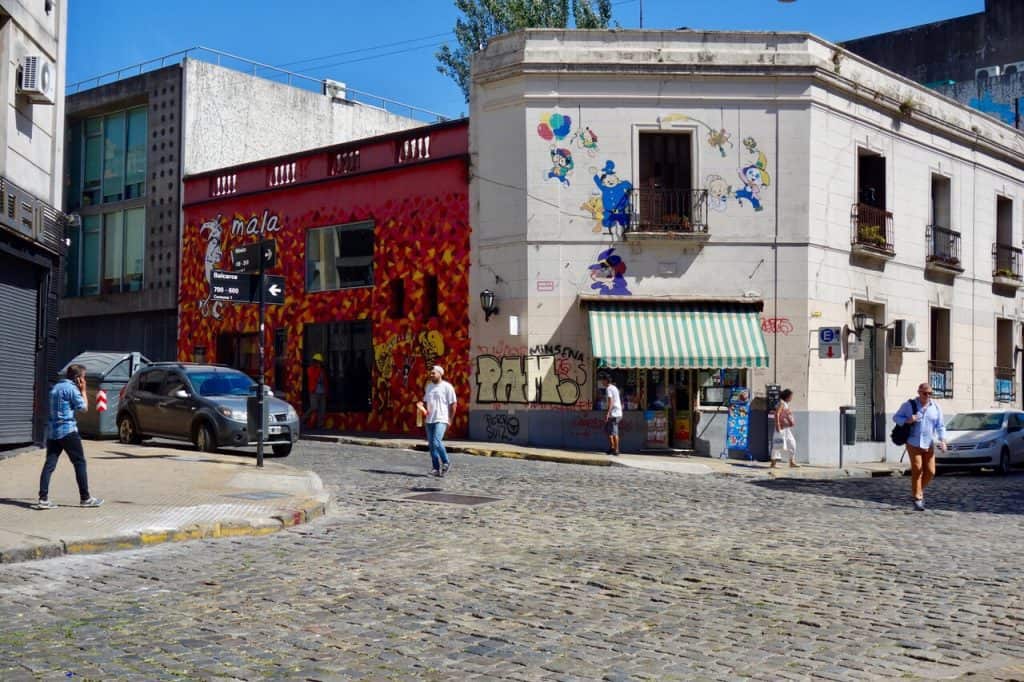
On our way from San Telmo to La Boca, we stopped under a bridge. Cesare pointed out that this area was the site of the infamous “Athletic Club” (Club Atlético), which was a notorious Argentinian detention and torture centre. Between 1976 and 1983, 30,000 people who were either political opponents of the government (or friends and families members of political opponents) “disappeared”. The area is now been preserved and will become a government-run museum.
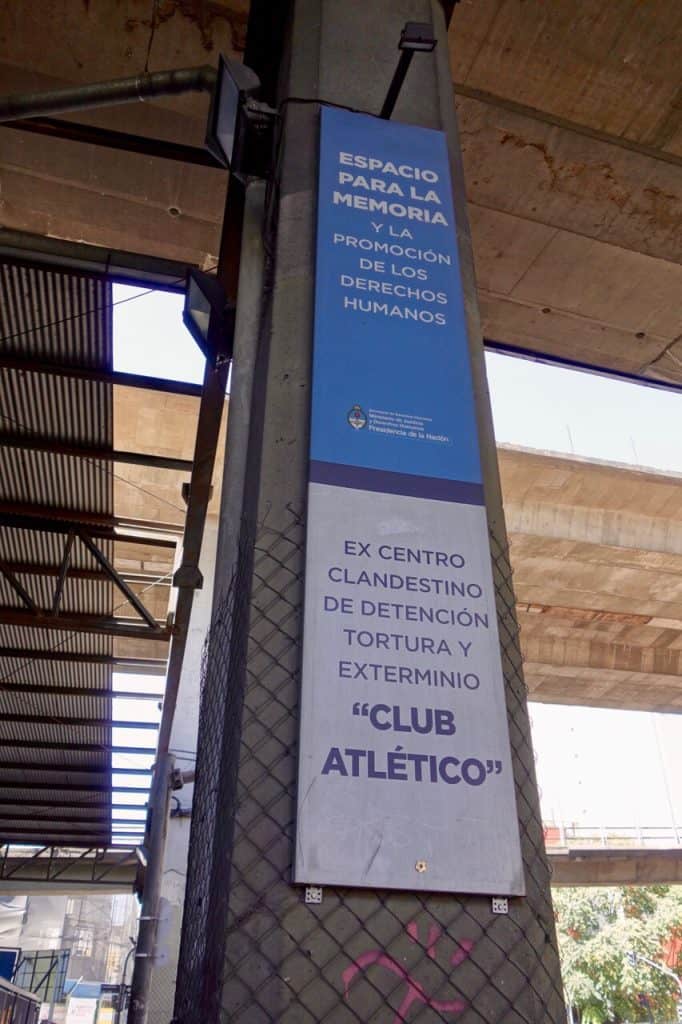
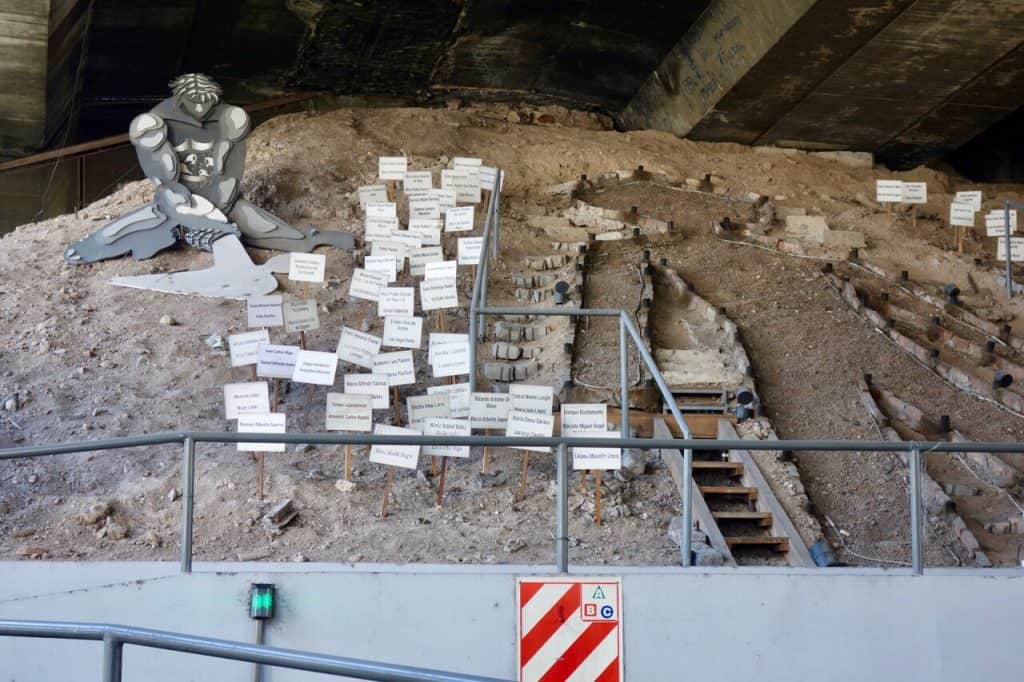
We made a quick stop in Parque Lemaza to learn about, and try, mate (mah-TAY), a tea made from dried yerba mate leaves. To say Argentinians like mate is an understatement. They are obsessed with it. Iguazu Park in Argentina actually features hot water stations for people to refill their mate cups. Cesare explained the perfect way to prepare mate. The water cannot be boiling; it must be very hot, but not boiling. If you use boiling water, you will wash (ruin) the mate.
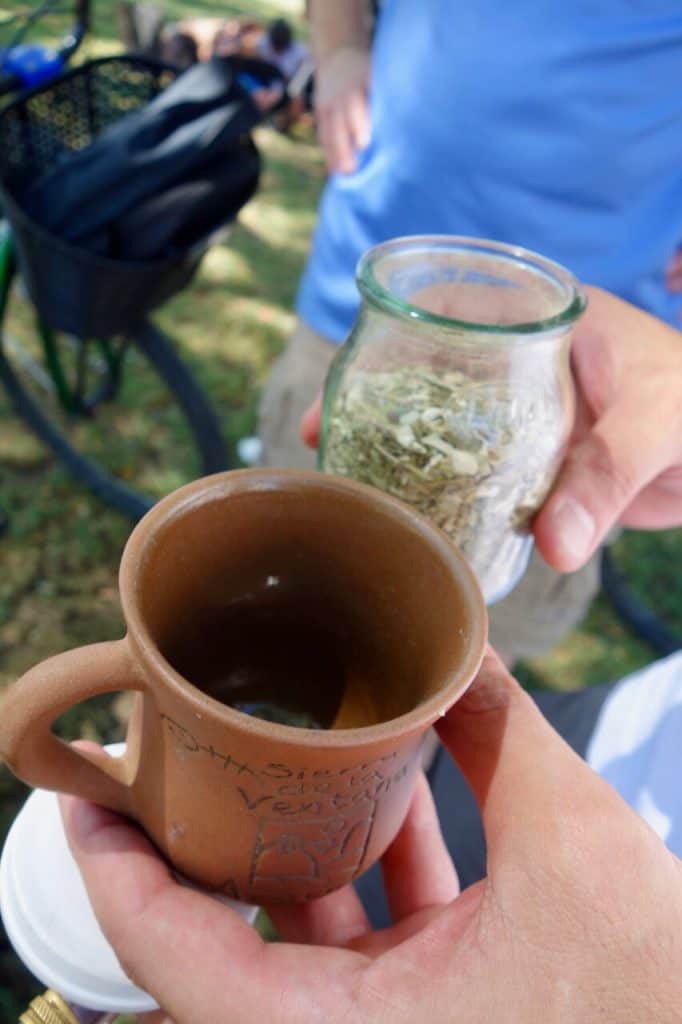
You start by pouring in a small amount of water, slowly stir it, then add a little more. You keep part of the leaves dry and only wet one side. The mate straw is metal with small holes in the bottom to filter out the tea leaves. Etiquette says that you do not touch the straw with your hands, as drinking mate is a communal affair. People share it. (Some companies forbid mate breaks and others allow employees to drink mate whenever they want, but not as a group activity.) First sips of the mate are bitter, but as more water is added, it tastes more like a fresh herbal tea.
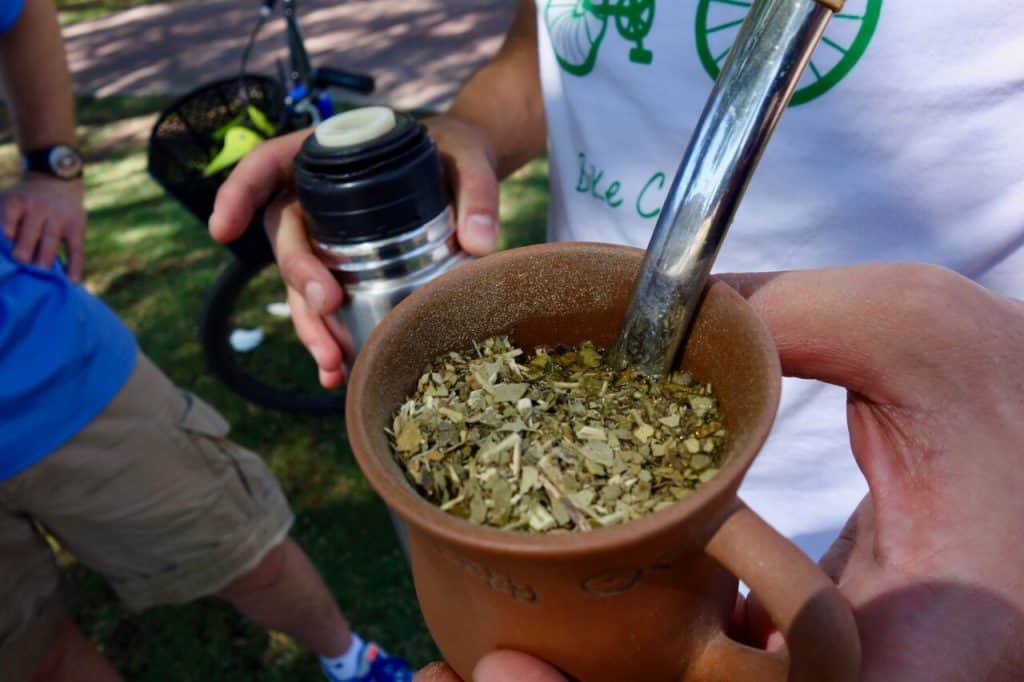
With the mate, we tried what are supposed to be mate’s perfect marriage, two different “medialuna”, which are like croissants. One was “fat” (the thinner one) and one was “butter” (which was sweeter, with a honey-type glaze on top).
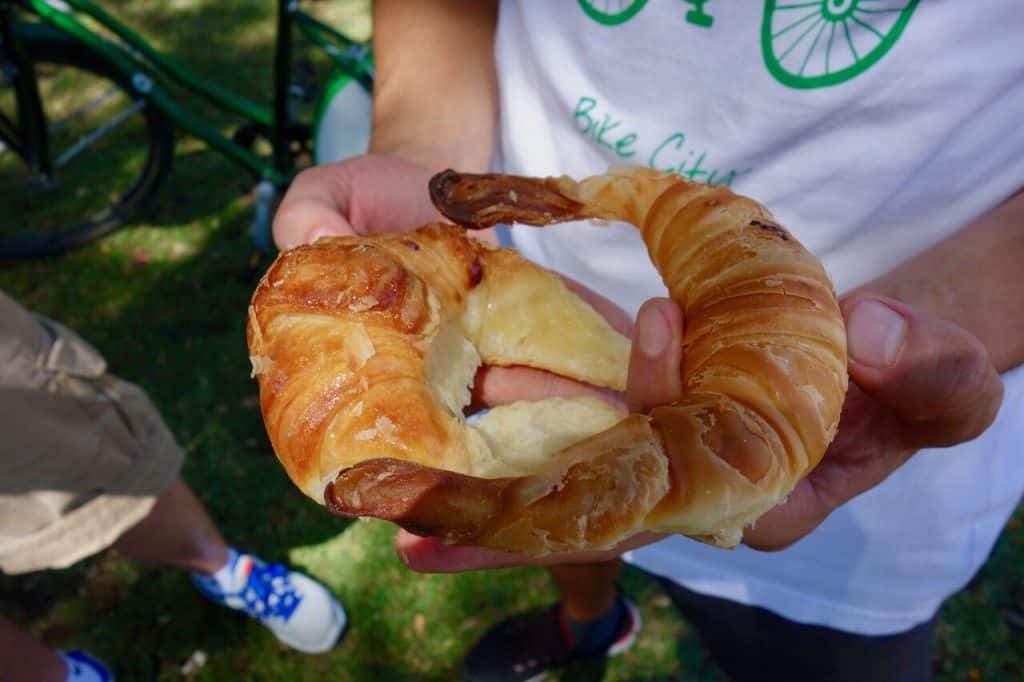
The Parque Lezama is on the border of the La Boca neighbourhood and features a large statue which was a gift from Uruguay in celebration of Argentina’s 400th birthday in 1936 (the anniversary of the landing of Spanish Conquistador Pedro de Mendoza). It took six years between May 25, 1810, and July 9, 1816 for Argentina to gain its independence from Spanish rule. Most towns have streets named “9 de Julio” and “Maggio 25” to commemorate these dates.
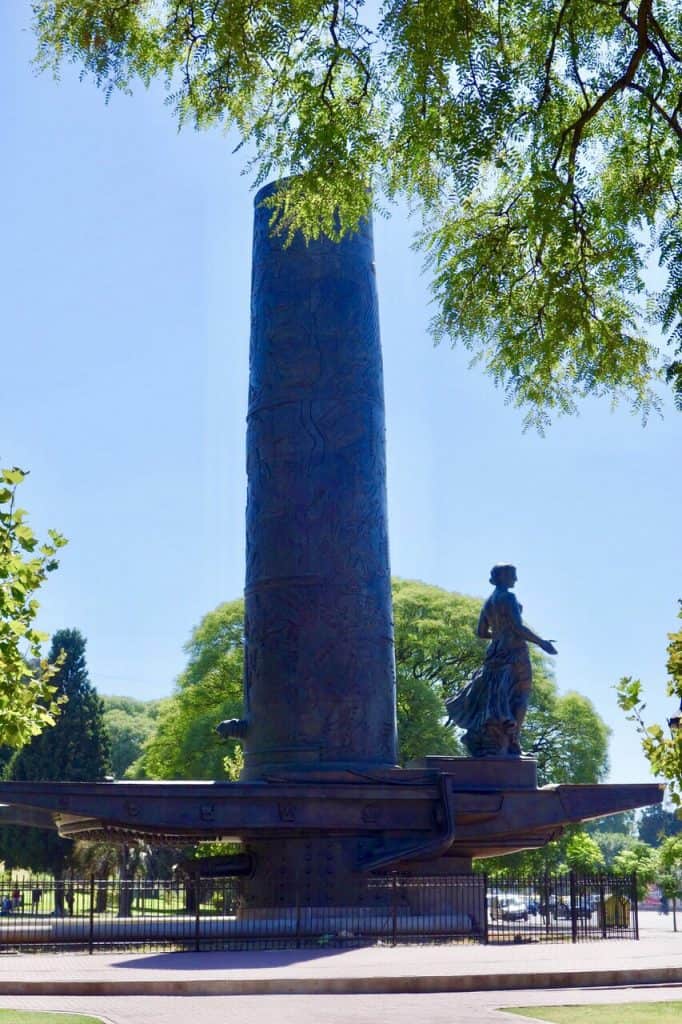
“We are now going to see a temple”, says Cesare, and we do. It’s the spot where “Porteños” (“those who live in the port”) pray during football season, the famous Bonbonniere. The stadium is the home of the CABJ (Boca Juniors) football team in all its gold and blue glory. The name was given to the stadium by the architect, who, when receiving a box of candy, commented “This looks like what I’m building”. The legend of the team’s blue and gold colours was explained to us. “They couldn’t decide what colour to give the team, but since the river is so important (the Boca is the mouth of the river), they went down to the dock and vowed to use the colours of the next ship that arrived. (We think the ship must have been from Sweden.) The stadium holds 50,000 fans.
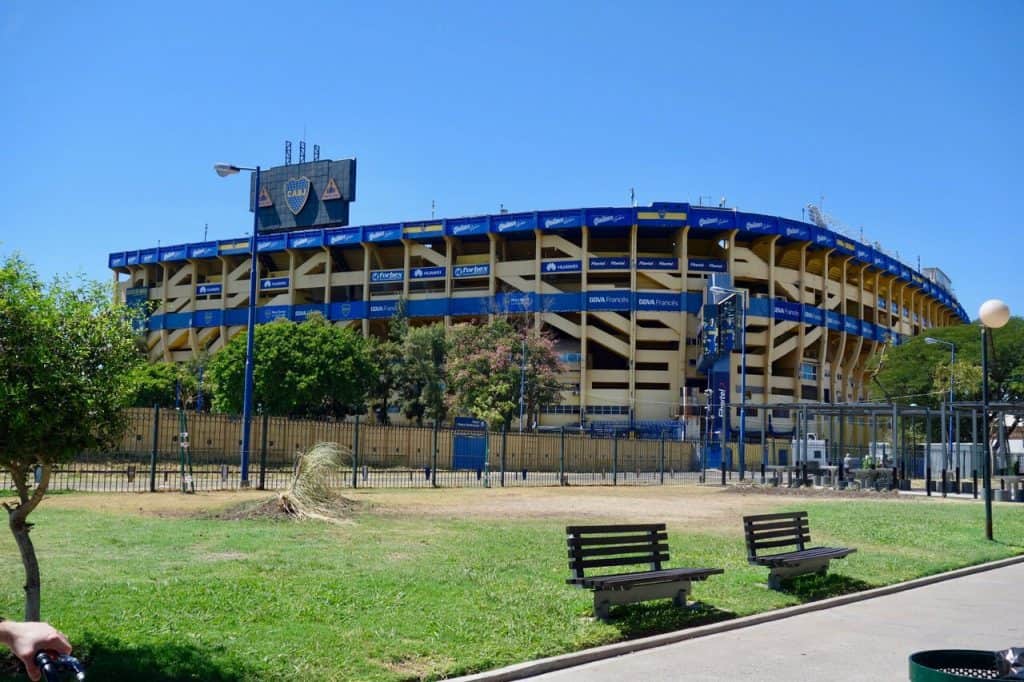
As a tribute, houses and walls in the streets surrounding the Bonbonniere are painted blue and gold, which blend nicely into the colours of our next stop, Caminito.
Caminito is the heart of La Boca. The multi-coloured, painted, corrugated metal houses in this poorer area are the result of excess paint from the boats that came into port. This was the area where most immigrants to the country settled – Italians, Spanish, Russians, etc. – as it was the cheapest area and prone to flooding from the river that divides the city and the province.
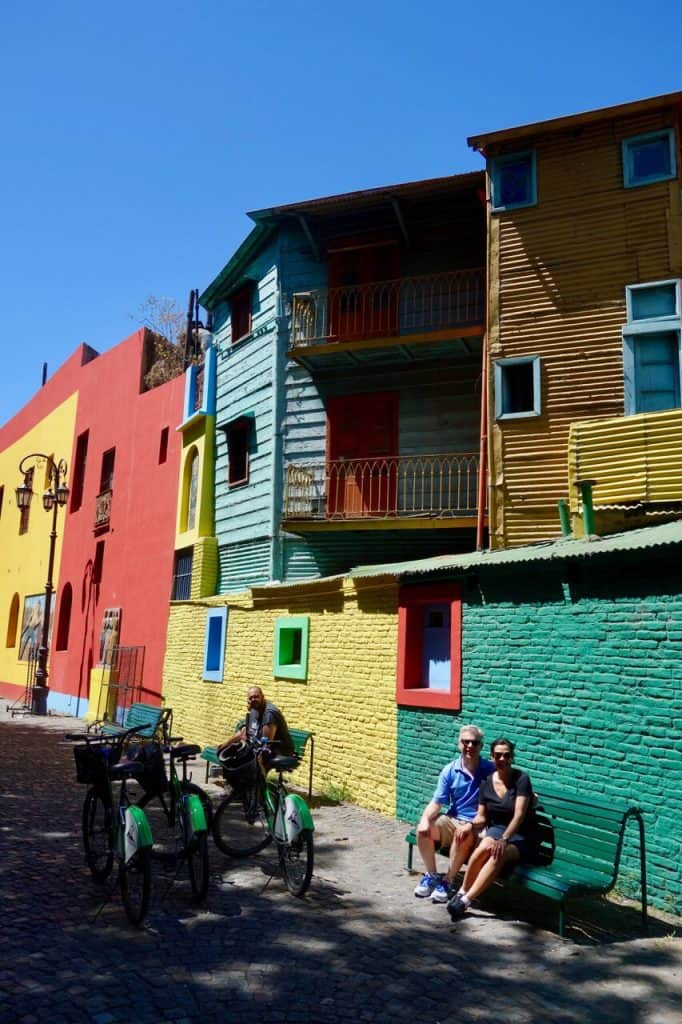
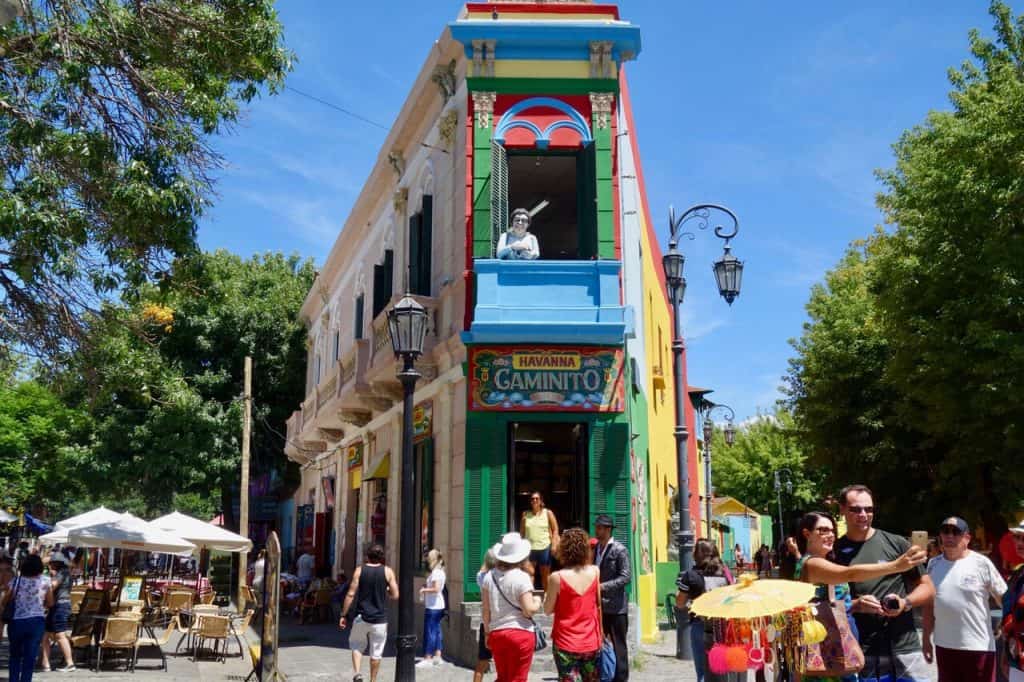
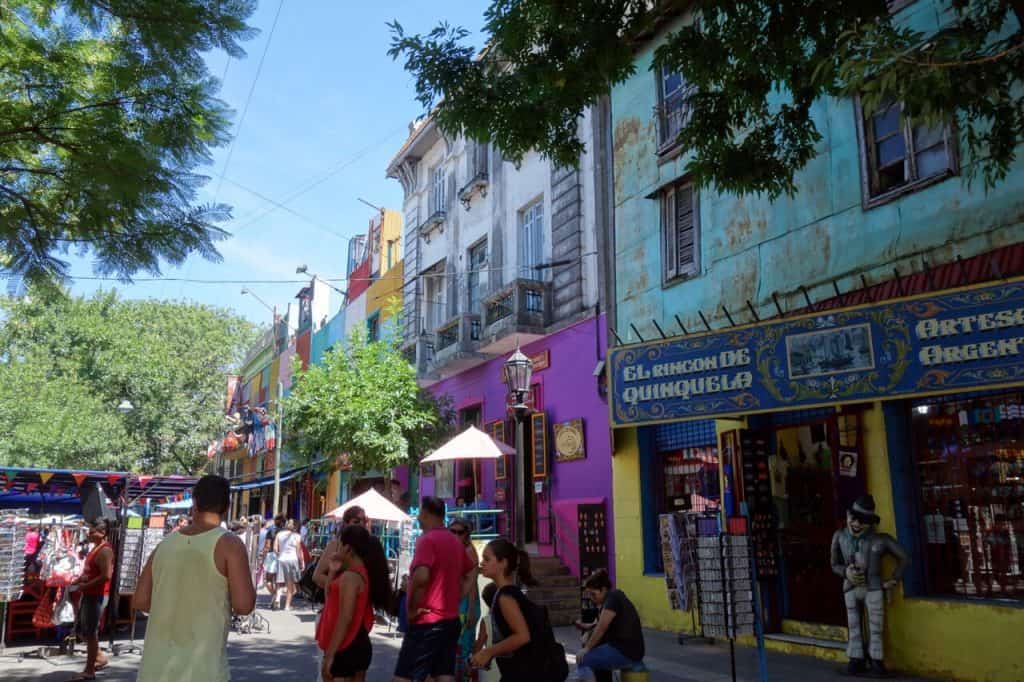
This is also the area where tango was said to have started. Originally, the tango was danced by men only as a macho demonstration – the sweeping foot movement was intended to mark territory. Tango became trendy with the rich people after it became popular in France. The Caminito area no longer houses people – it is now an open-air museum, filled with restaurants and shops.
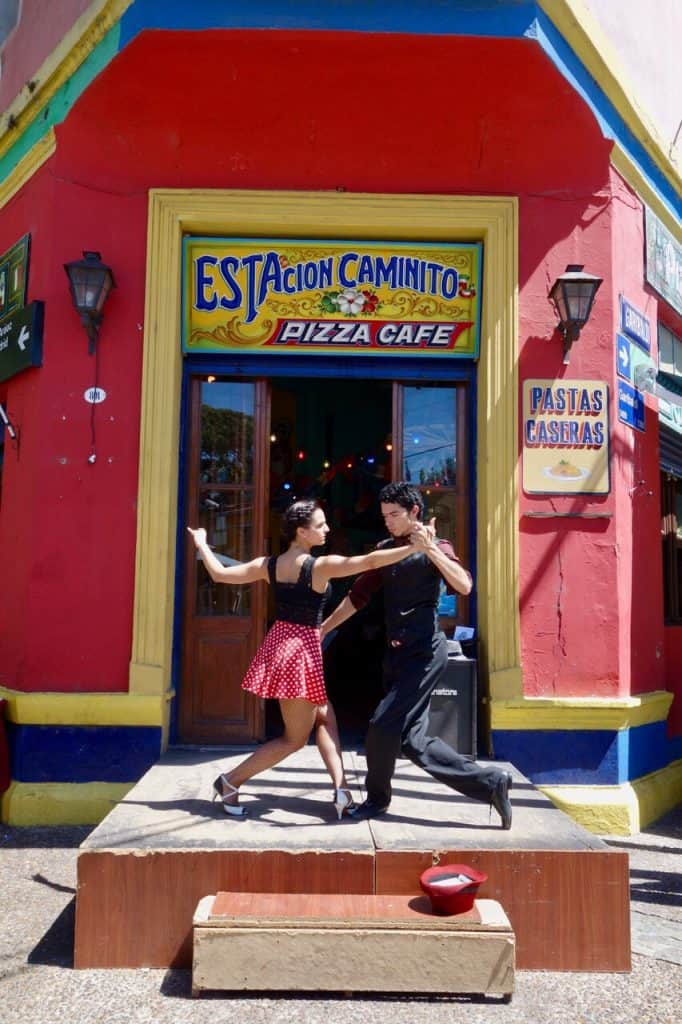
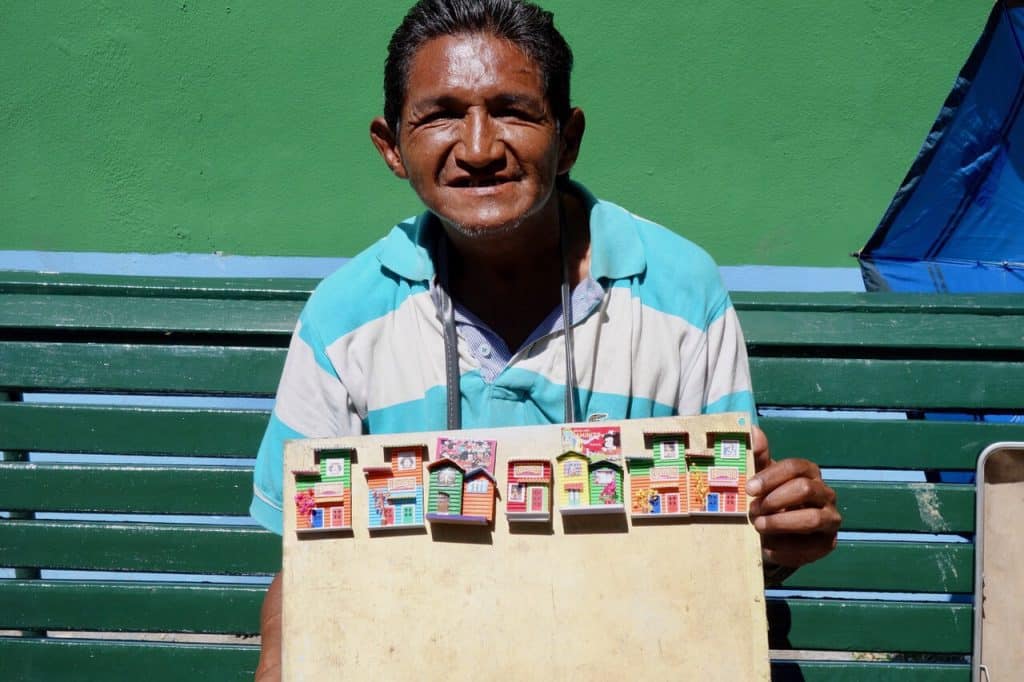
Banchero de la Boca is our next food stop. This place, explained Cesare, created the “Fugazzeta” which is now popular all over the city. The restaurant is filled with old-school waiters (our waiter has been there since 1983). The place started as a bakery in 1932 over 85 years ago and was one of the first places in Buenos Aires to serve pizza.
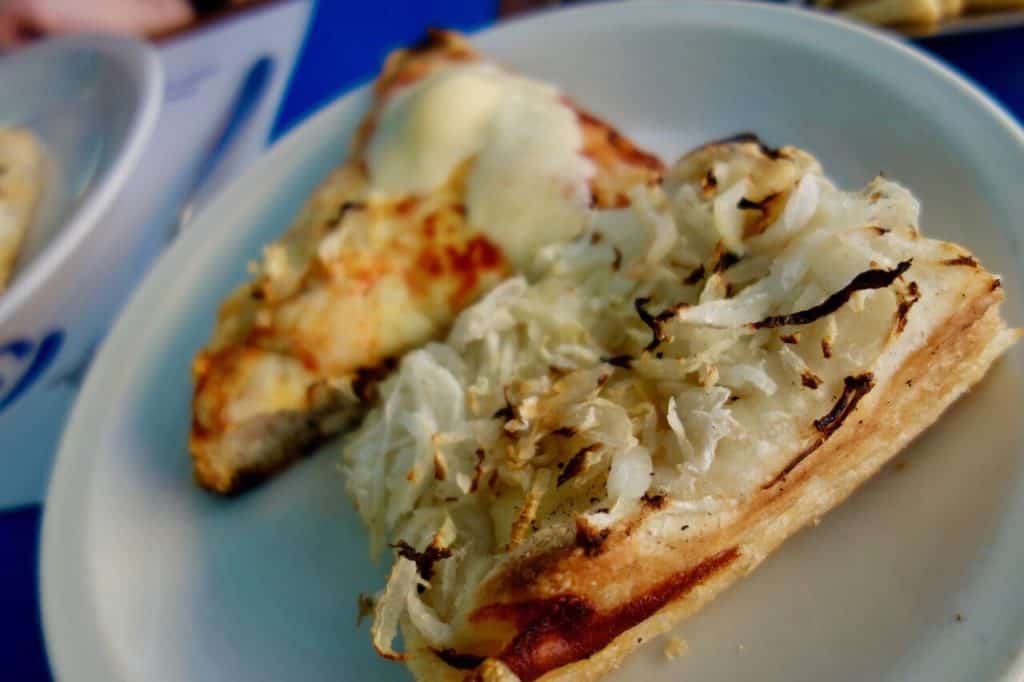
We try a ham and cheese empanada, a meat empanada, a mozzarella pizza (think Chicago deep-dish style) and the famous Fugazzetas with onion and cheese (similar to a focaccia) and super-delicious.
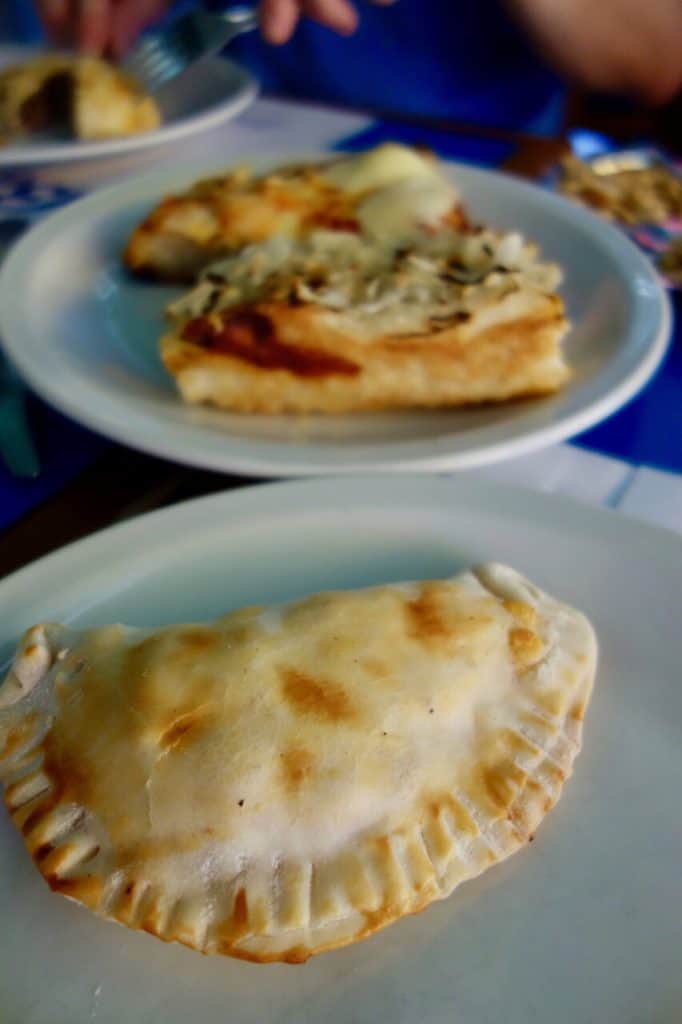
The restaurant has photos from days gone by, including one photo that we were pretty sure featured Firpo, “The Wild Bull of Pampas”, whose grave we had seen the day before in the Recoleta Cemetery.
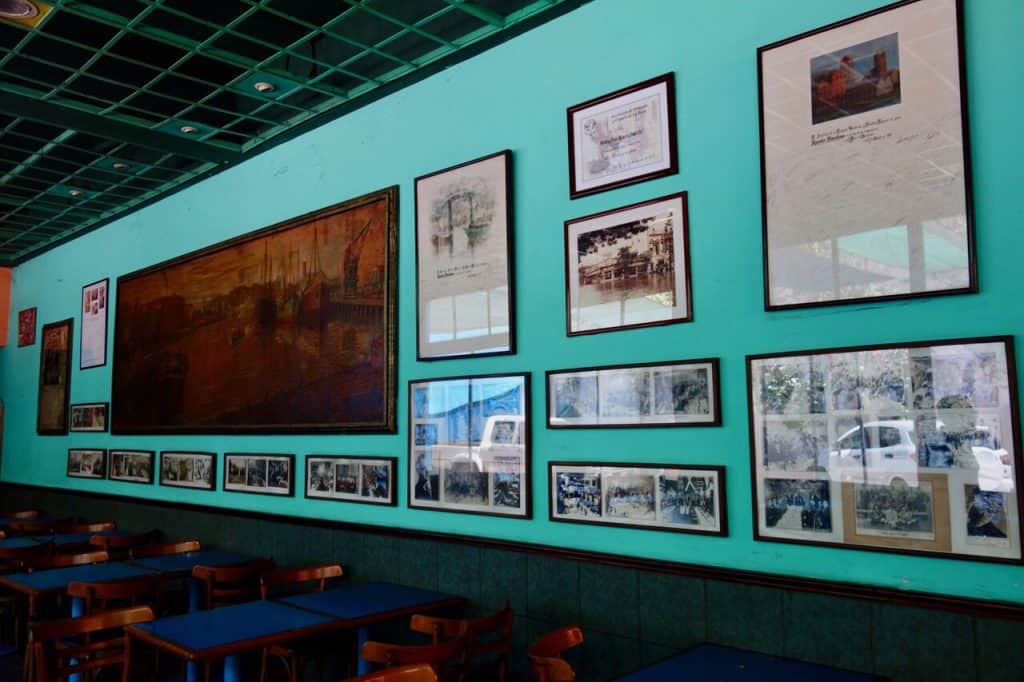
How important is the Pizzeria Banchero? It was declared a site of Cultural Interest in 2002!
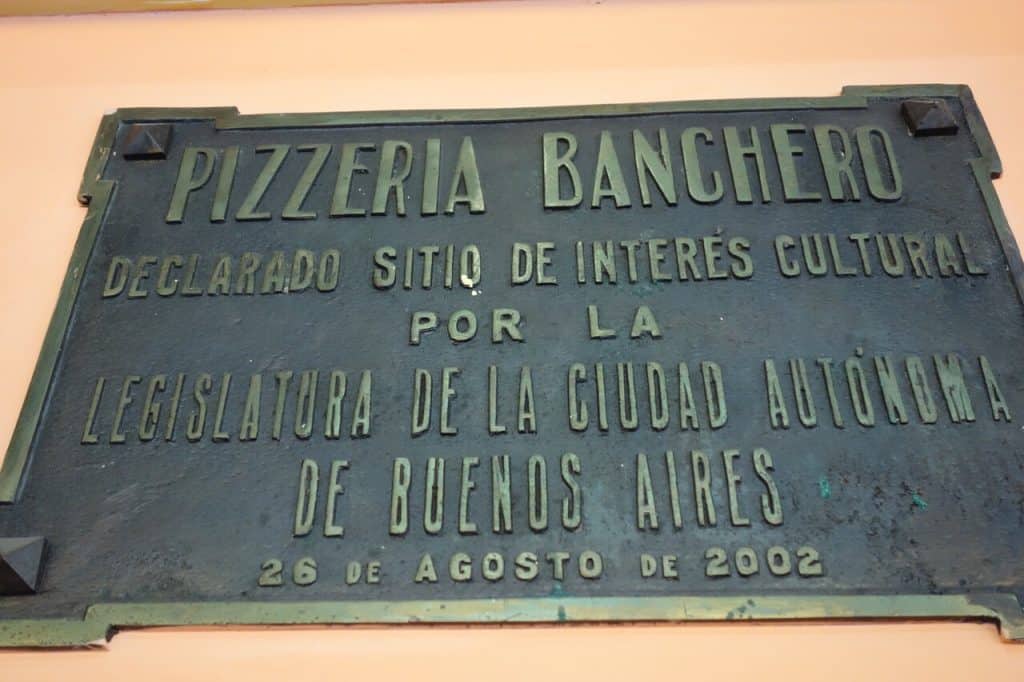
The area is crazy for street art, which is evident throughout the city. A new cultural centre has taken over the spot that was a power station. There seems to be a lot of rebuilding and restoration. As we move closer to the waterfront, we see massive condo developments. The area that twenty years ago was a landfill site is now the site of a new development. Fifteen years ago, they started building restaurants and offices. Ten years ago, the condos started to rise up. Right now, we counted approximately ten new developments.
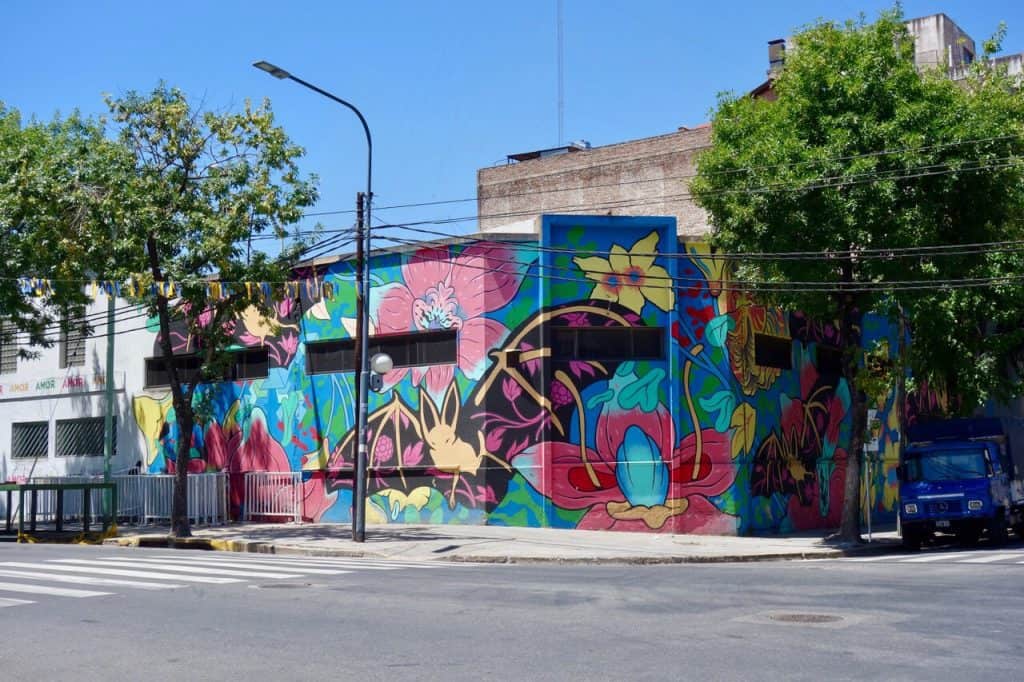
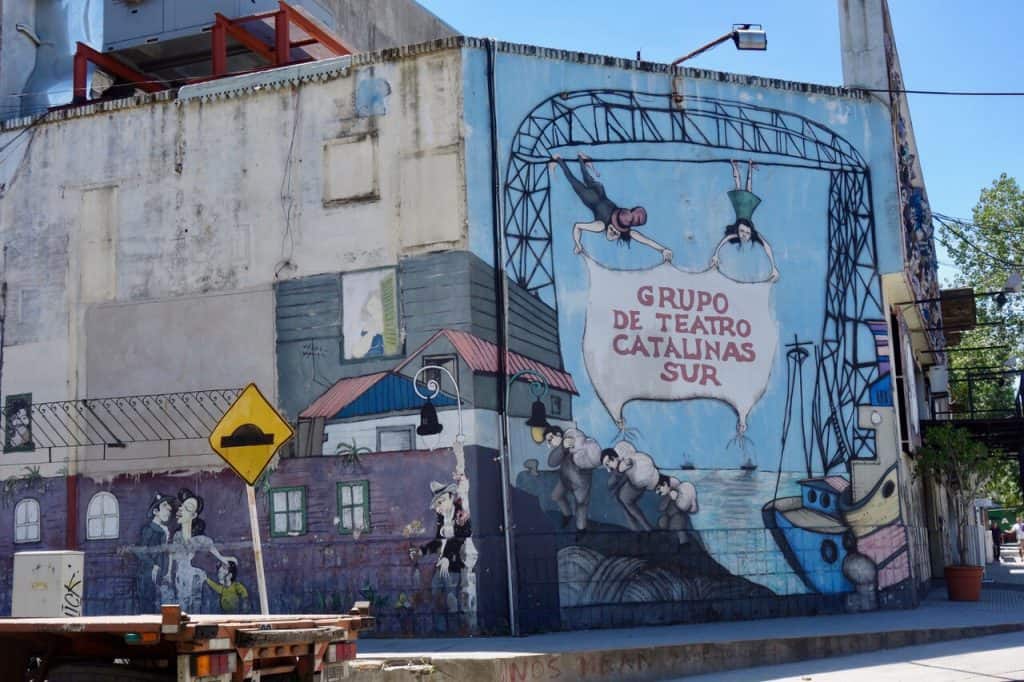
There is a large walkway which runs along the water which is home to several food trucks.
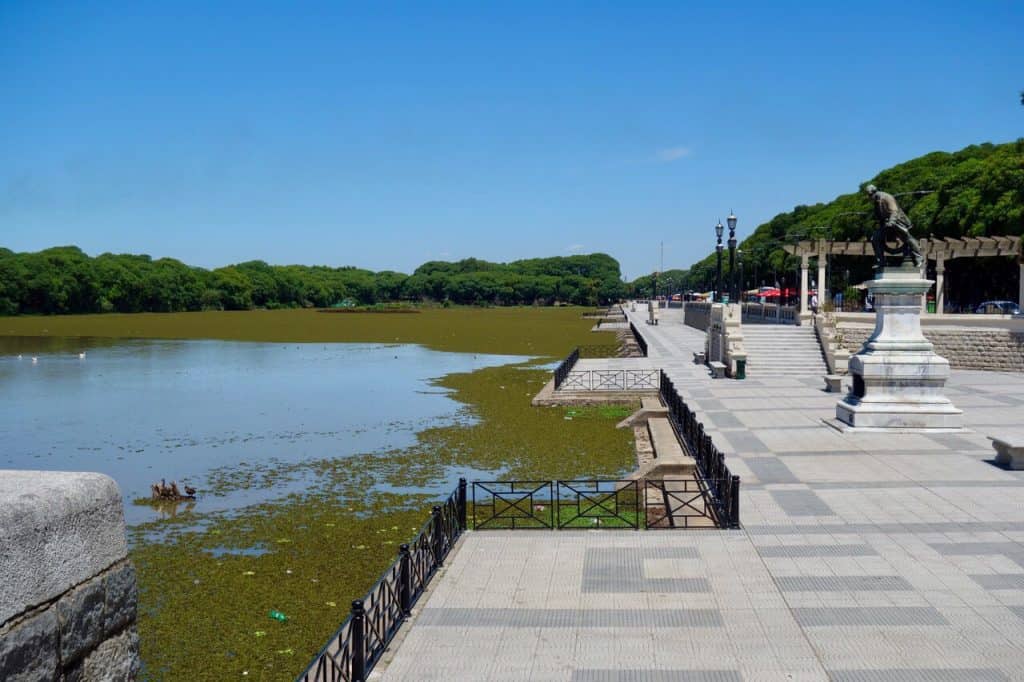
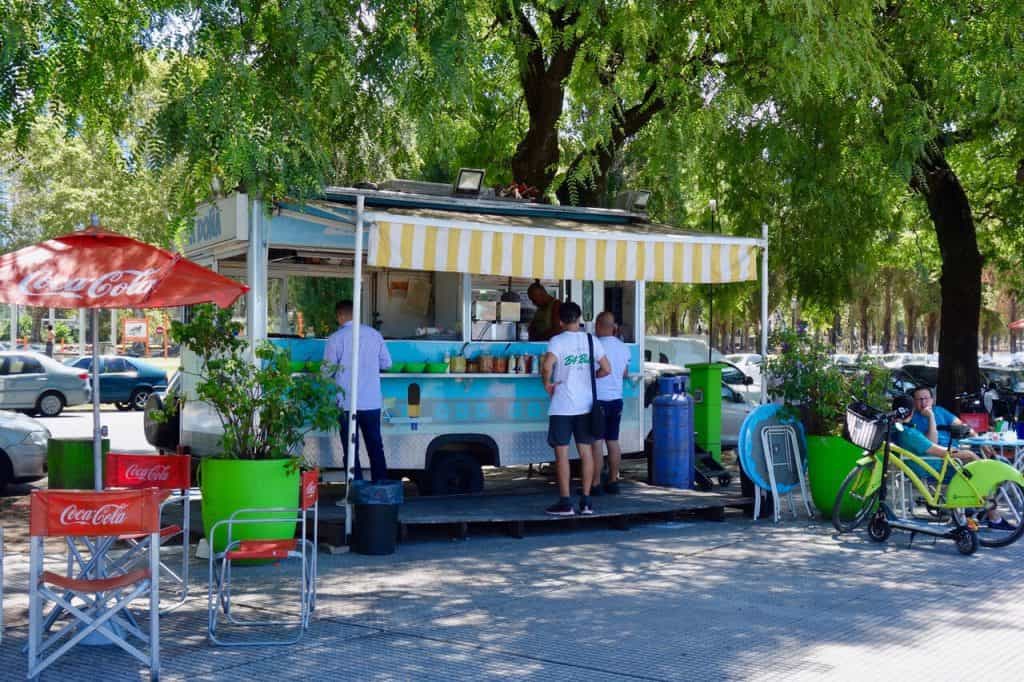
We stop for our next food break to try the Choripan, which is a chorizo on a bun. You can order these simple or complete. Complete means they add ham and cheese. The Choripan might be another national food! It recently made the Buzzfeed’s list of “Savory Latin American Snacks to Try Before You Die“!
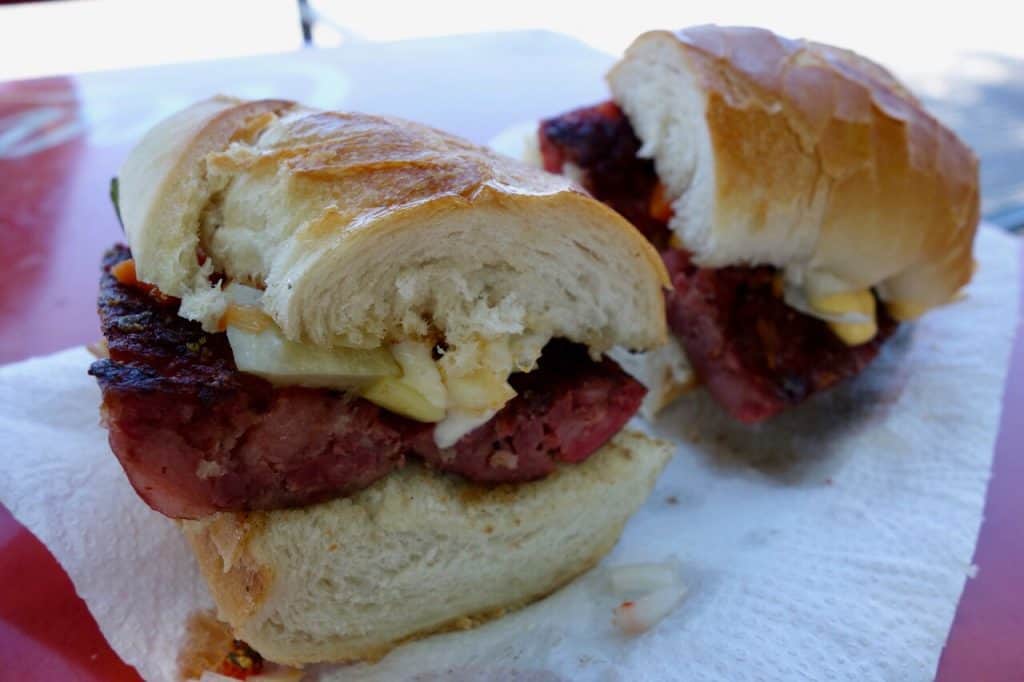
Sauce and topping fans will rejoice! There are so many different cheese sauces (Parmigiano, blue, queso) and pickled items to choose from! The other fan favourite sandwich was the Bondiala which was thinly sliced pork on a bun (at this point, we were getting pretty stuffed, so we opted for the Choripan only).
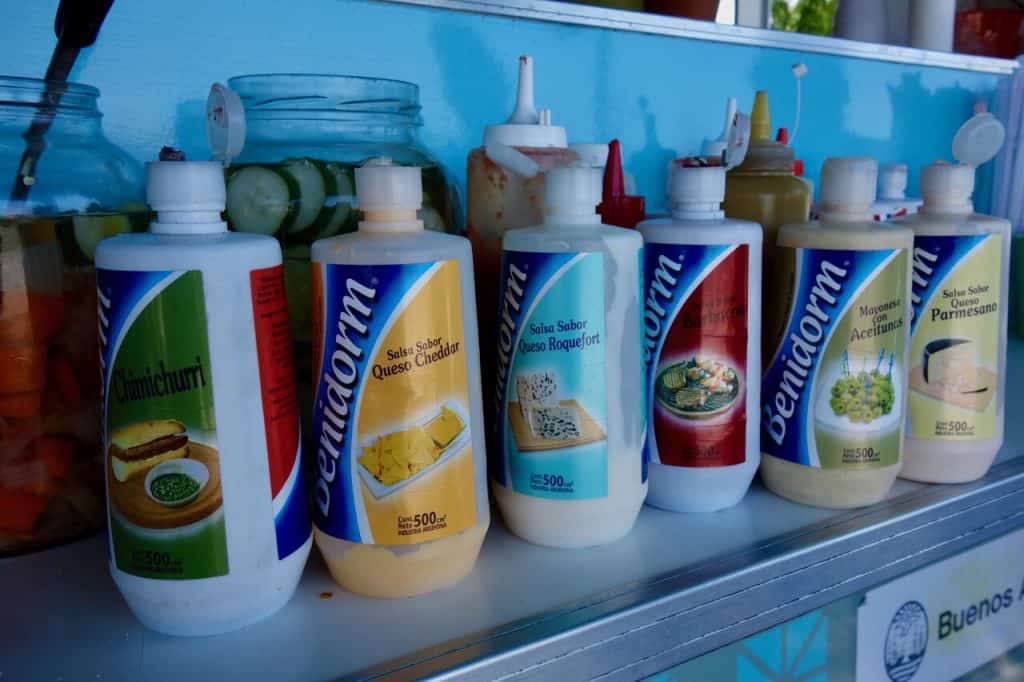
The intention was for nearby Puerto Madera to be the second port of Buenos Aires. It was abandoned in the 1920s when, after much work, it became apparent that the area was too shallow for boats to enter.
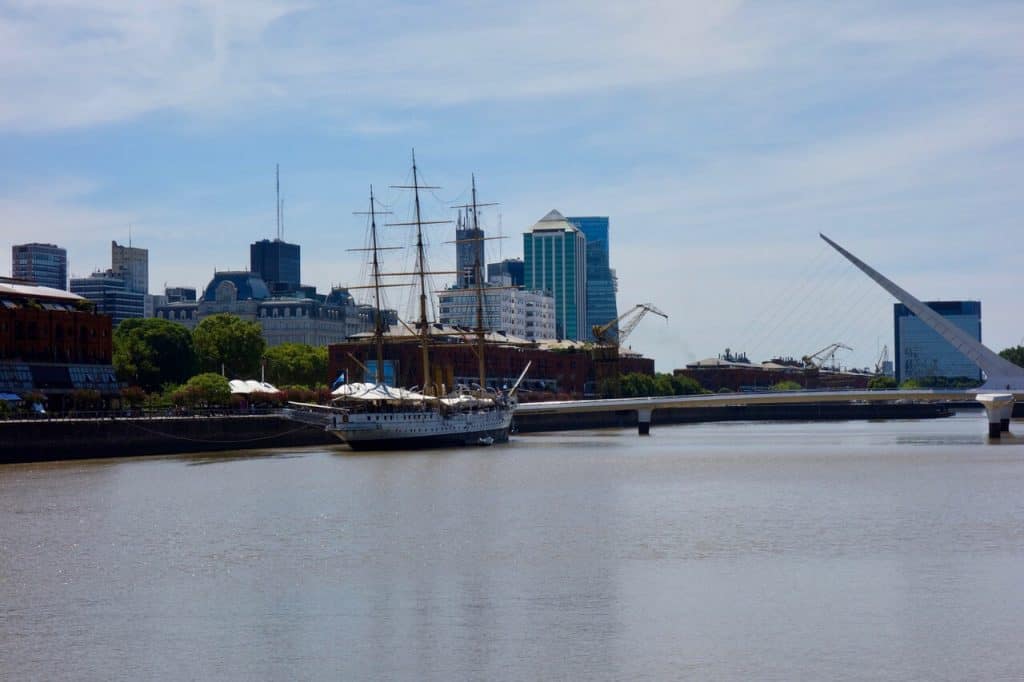
Huge port cranes installed to loan and unload ships were left abandoned. Cesare mentioned that he used to climb them as a young boy. In the early 2000s, restaurants and offices started appearing, followed by condos.
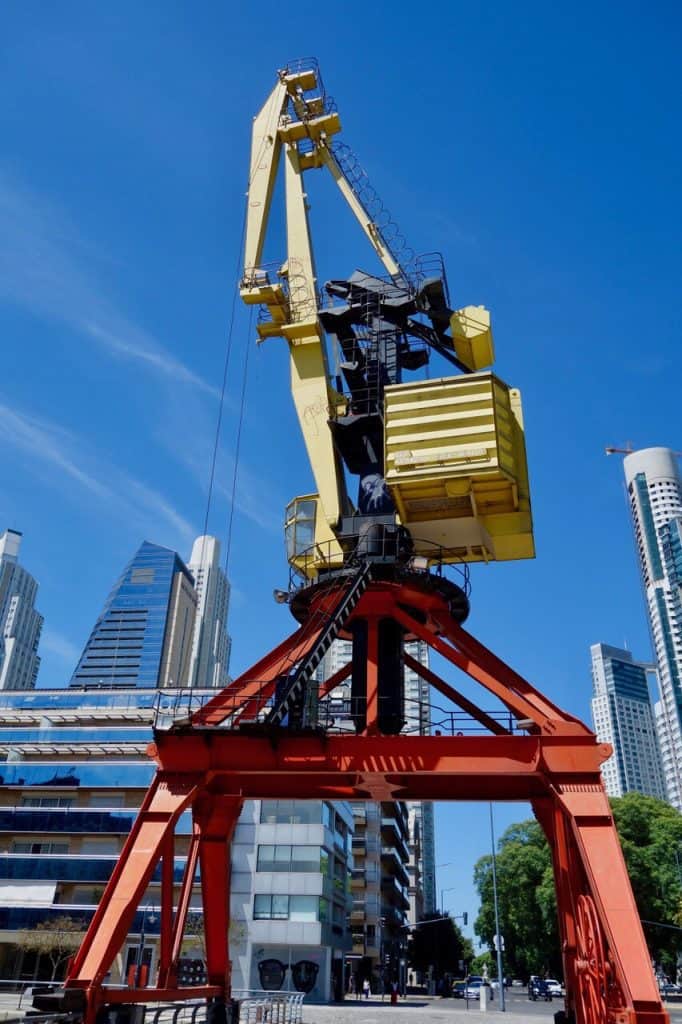
The area is now the most expensive place to live in Buenos Aires, with prices for an apartment around US$1,000 per square metre. The area is close to the main square (Plaza de Mayo), yet there is no public transportation to or from it, a fact that the new condo owners seem to like.
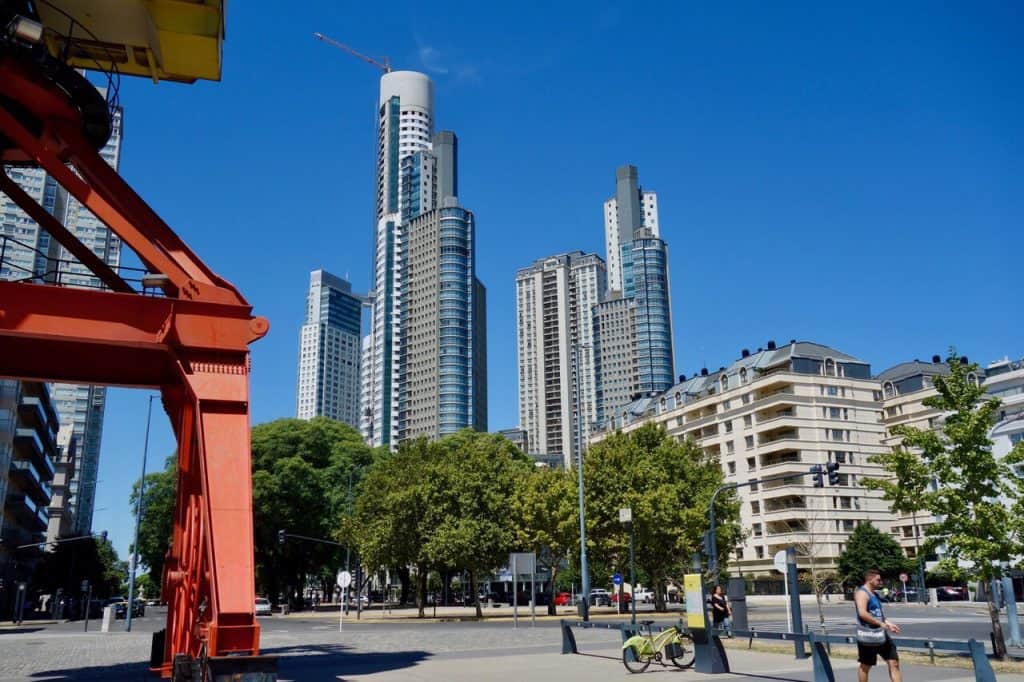
One last stop before we head back: helado! Italian culture has such an influence in Buenos Aires that gelato (or in Spanish, helado) is a everywhere! We stopped at Freddo where we try dulce de leche flavour (of course). I couldn’t resist the SPRITZ (!!!) flavour with my dulce de leche, while Pete opted for banana. Having eaten our fair share of gelato in Italy, we can attest that this is the real deal!
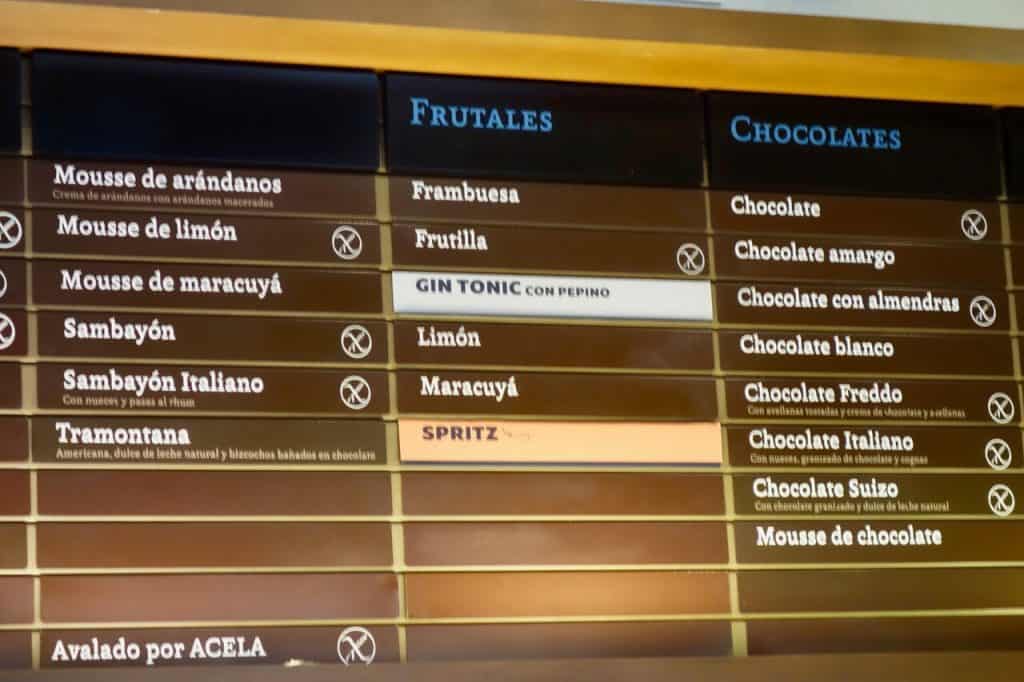
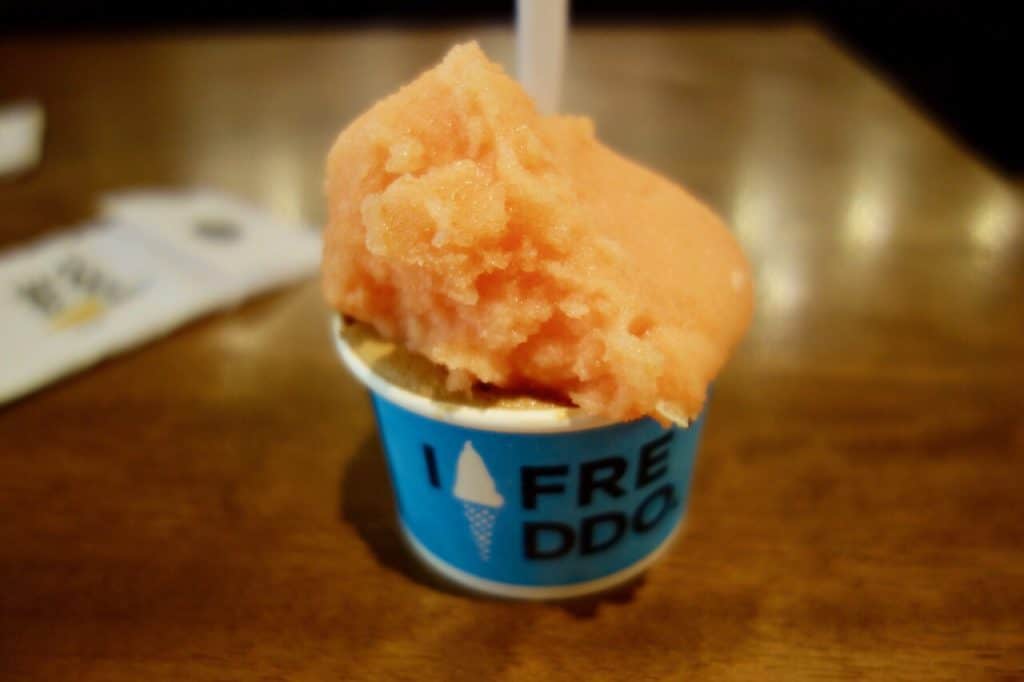
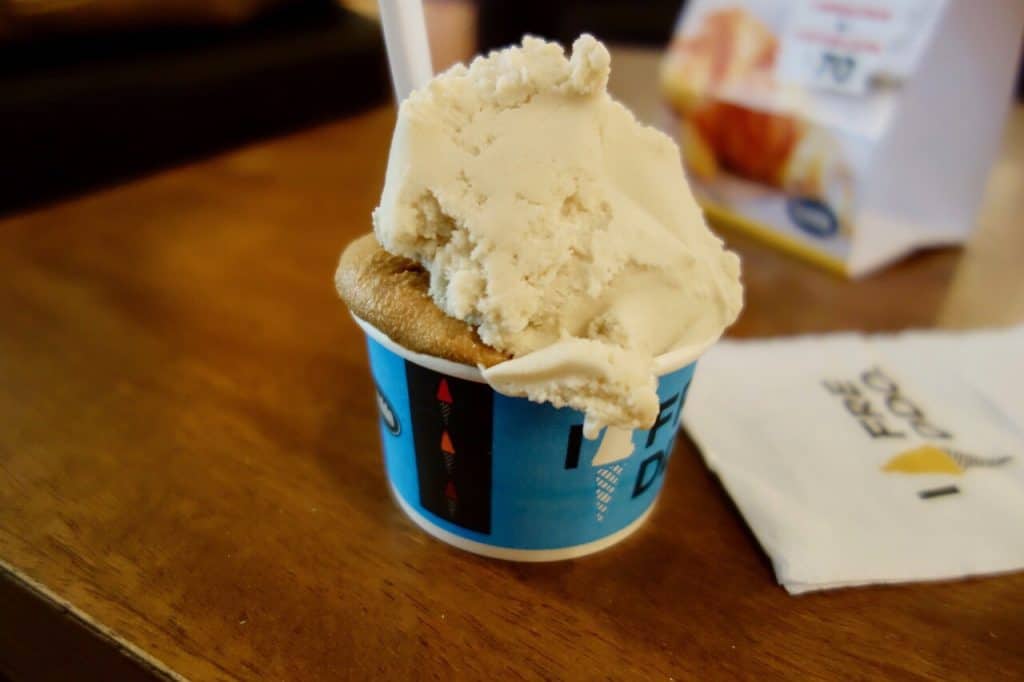
Sadly, our day has to come to an end. We biked up to the square in San Telmo (where they have antique fairs on Sundays) and then back to BA Bikes.
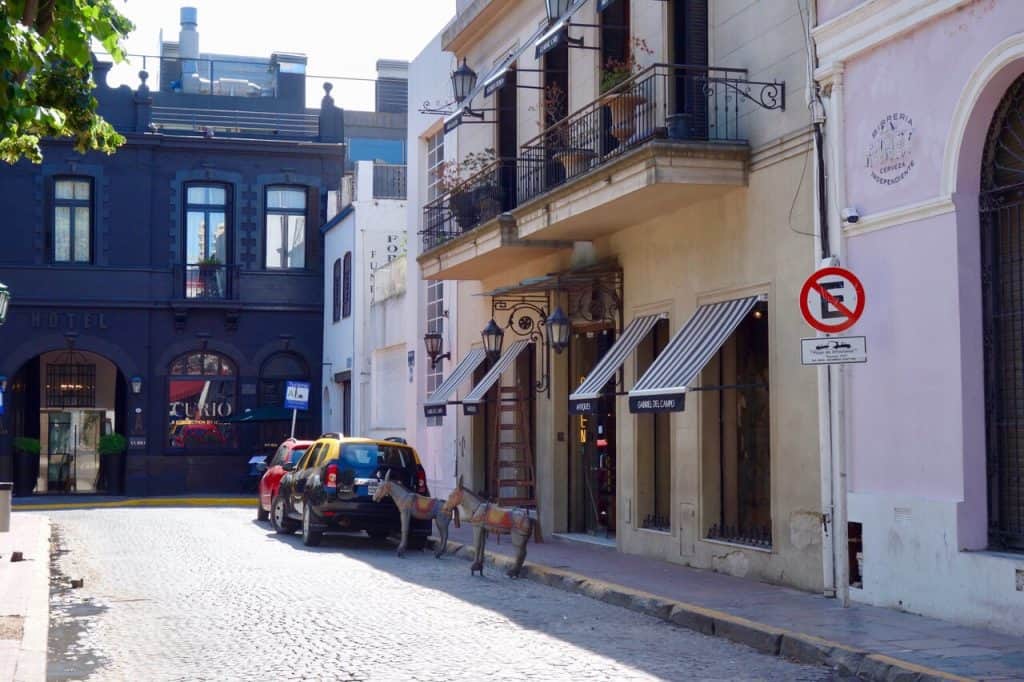
We would like to thank Cesare and Juan for showing us the south side of their amazing city. If you are in Buenos Aires and want a different way to see the city, we would highly recommend doing a tour with BA Bikes. They run group tours every day at 9:30 and 2:30. You can pick the North Circuit, the South Circuit or sign up to do both. Their Food Bike Tour is everyday at 10:30 and they are available for private tours (which we did).
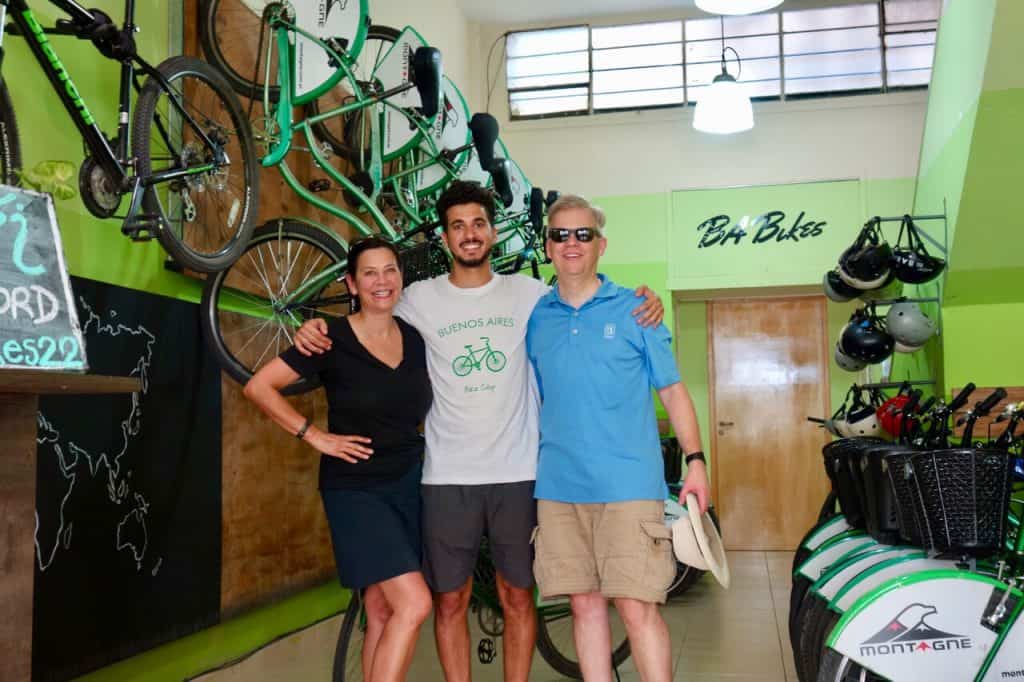
Get a different view of the city and see it by two wheels with a local guide. We had a blast and we are so happy to put this on our “things to do” in Buenos Aires list!
Interested in more Argentina? Maybe a cocktail after that ride? Check out the Secret Speakeasy here. Something further afield? Read about Iguazu Falls here.






















That looks like so much fun!!
It was! We had a great time and really enjoyed seeing the city this way. We felt totally safe the entire time.